
A newspaper article in the May 6, 1917 issue of the Durham Morning Herald. The author is unknown. Accessed courtesy of Newspapers.com and the University of North Carolina at Chapel Hill.
This document is an article from May 06, 1917 that details the dispersal of a letter to farmers in Durham County. The article also contains a transcription of the letter. In the letter, the commission that has written it, comprised of members of the county board of agriculture, urges farmers to join in the war effort by increasing production of their crops and making the most use of their land. The letter begins with the phrase: “Grow your own food and feed crops or go hungry.” [1] This line was created by the North Carolina Food Conservation Commission and graced thousands of letters, articles, and other forms of propaganda that were part of a four-month campaign to “reshape a State wedded to cotton and tobacco.” [2] Shifting the entire agricultural landscape of the state was no small feat and as a result, campaigns such as these were needed to motivate farmers to join the cause.
The letter is divided into two parts, a section from President Wilson and further writing from the Durham County Board Of Agriculture, but their message is the same: a call to arms to the farmers of Durham County, telling them that it is their “patriotic duty” to produce as much crop as they can to send to the Armed Forces and to keep the population at home in the United States well fed. Usual inter-state forms of transport and conduits of trade were being devoted entirely to the war effort in 1917, three years into World War I. As a result, farmers were not only motivated to produce food for soldiers, but also to produce enough food for themselves at home and the horses, hog, and cattle on their farms, so as not to rely on imports that may be needed elsewhere. To give you a sense of the magnitude of this change, when asked to what extent North Carolina had stopped drawing upon surplus food that may have been available to European markets, the North Carolina Food Conservation Committee offered this answer: “Whereas, 25,000,000 bushels of corn were imported in 1916, little, if any, will be shipped into the State this season. There will be 100,000,000 pounds of pork available for other export channels because of the stimulus to swine production. The hitherto enormous importation of canned goods will be less than 20 per cent. the quantity of previous years. Wheat and other products were conserved to a corresponding degree.” [2] These massive shifts in production and importation would have caused an equally dramatic shift in the foodways of the area, and Chapel Hill would have been forced to adapt and modify everything about food production and preparation in order to cope. Imagine a North Carolina with no corn and therefore, no cornbread. These were dire times indeed.
Knowing exactly what crops were being grown is crucial to the Chapel Hill food story. Within the letter, they implore the farmers to use as much fertilizer as possible in the production of such crops as “Irish potatoes, corn, beans, cabbage, sweet potatoes, peas, soybeans, and tomatoes” [1] Other sources within my group speak of food preservation and conservation methods but without the output of crops by farmers, there would have been no food to conserve in the first place. All of these factors provide insight into the unique position southern agricultural states held in the war effort, with the call to the fields being more prevalent than a call to arms.
Works Cited
[1] “Durham Morning Herald.” Accessed November 1, 2018. [2] Winters, S. R. (Sellie Robert). Food Conservation in North Carolina. American Review of Reviews. Vol. 56, no. 5, Nov 1917. Documenting the American South. 2002. University Library, The University of North Carolina at Chapel Hill. Accessed November 1, 2018 <https://docsouth.unc.edu/wwi/winters/winters.html>.
